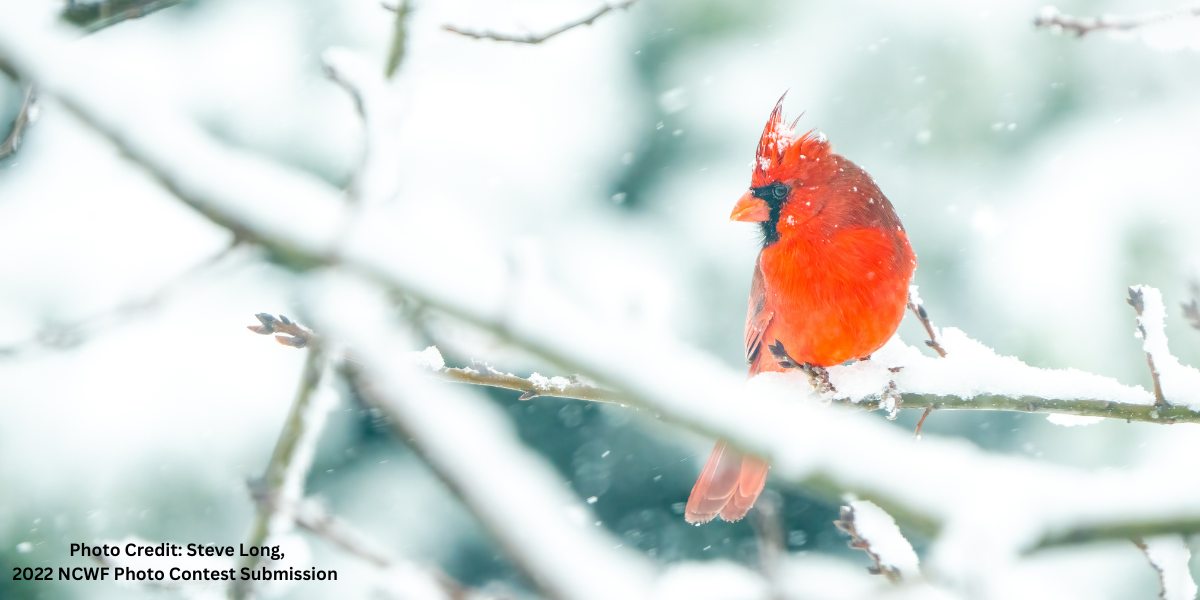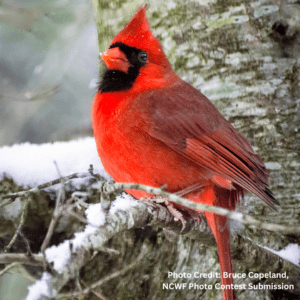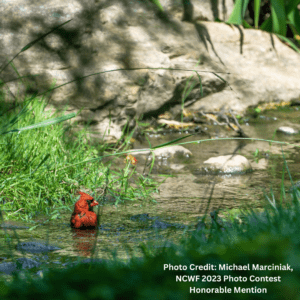Northern Cardinals: Get To Know NC’s Official and Beloved State Songbird

There is more to cardinals than a baseball team mascot!
The changing seasons bring a kaleidoscope of new colors, shapes, sounds, and life to North Carolina’s natural landscape. Some species are seasonal migrators, spending either the cold or warm months in the state before giving way to other seasonal inhabitants.
 Yet, North Carolina is not devoid of residential constants.
Yet, North Carolina is not devoid of residential constants.
The ever-present shadows of white-tailed deer passing through stands of pine, gray squirrels traversing overhead in interconnected boughs of hardwoods, red-tailed hawks circling over fields in search of quarry, and a dot of vibrant red darting through the bare branches of winter, as well as the luscious green of summer: North Carolina’s official state songbird, the Northern cardinal.
Northern Cardinals: Description, History, and Status
Widespread across the state, the Northern cardinal (Cardinalis cardinalis) is cherished for its distinctive appearance and unique song.
Male cardinals boast vibrant red plumage, earning them their name after Cardinals in the Roman Catholic Church, known for their red cloaks and caps.
Female cardinals display a more muted, olive-red hue, with both genders featuring a noticeable crest on their heads. Concerns may arise at the sight of a cardinal with a bald head or spotty feathers, but this is a natural occurrence during the bird’s annual molting.
Cardinals, non-migratory songbirds, inhabit a broad range extending from Canada to Guatemala, covering the eastern and southern United States, excluding the western region. Commonly found in urban and rural areas, they frequent seed bird feeders due to their seed-heavy diet.
Primarily granivorous, cardinals consume up to 90% seeds and grains, supplemented by fruits and insects. Incredibly territorial, males seek high perches to sing, establishing their territory and displaying aggression towards other birds, even attacking their reflections in windows. This behavior tends to diminish in late summer with the waning of breeding and territorial hormones.
 While Northern cardinals can live up to 15 years, one in captivity has been known to reach nearly twenty-nine years.
While Northern cardinals can live up to 15 years, one in captivity has been known to reach nearly twenty-nine years.
Once prized as pets, their sale was prohibited by the Migratory Bird Treaty Act of 1918. Currently, they are a species of low conservation concern, with a global breeding population of around 130 million. According to the North American Breeding Bird Survey, their numbers have increased by an estimated 0.32% per year since 1966.
Though the Northern cardinal’s population is stable, they are still at risk as a result of urbanization and habitat degradation.
To support Northern cardinals and other native songbirds, consider planting native seed-bearing plants in addition to seed bird feeders. Popular native plants for red cardinals include dogwood, mulberry, blackberry, beauty berry and sumac.
Northern cardinals do not typically take long-distance flights, so they rely on low brush cover for resting, hiding, and nesting. Any native shrubs that you can plant near food sources or wood edges are helpful to provide shelter and nesting opportunity.
You can also register your yard as a Certified Wildlife Habitat. This involves providing wildlife in your backyard with the essentials they need to survive, including:
Food: Native plants provide wildlife with nectar, seeds and berries. Feeders can supplement.
Water: All animals need water to survive and some need water for bathing or breeding.
Cover: Wildlife needs shelter to escape bad weather and predators.
Places to Raise Young: Wildlife needs special habitats for bearing and raising young.
Find out more about how to make your yard a Certified Wildlife Habitat.
To find out more about how you can work to conserve Northern cardinals and other wild birds, read our blog Wild Bird Essentials: How to Provide Birds with Shelter, Food, and Water .
Written by:

– Bates Whitaker, NCWF Communications & Marketing Manager

